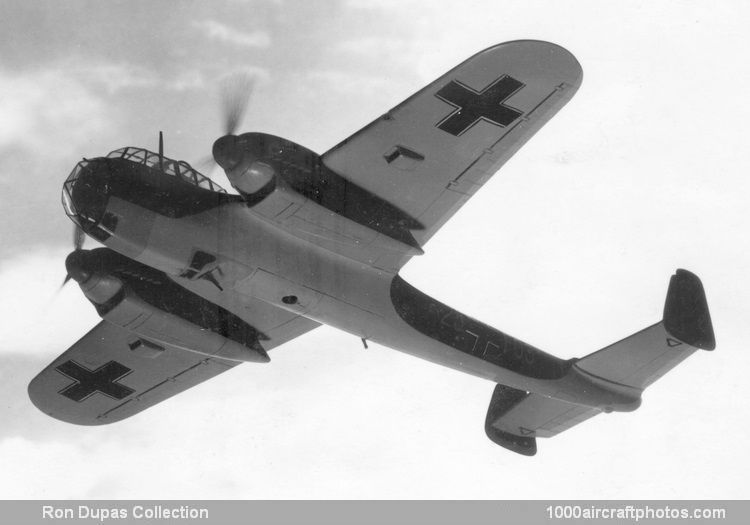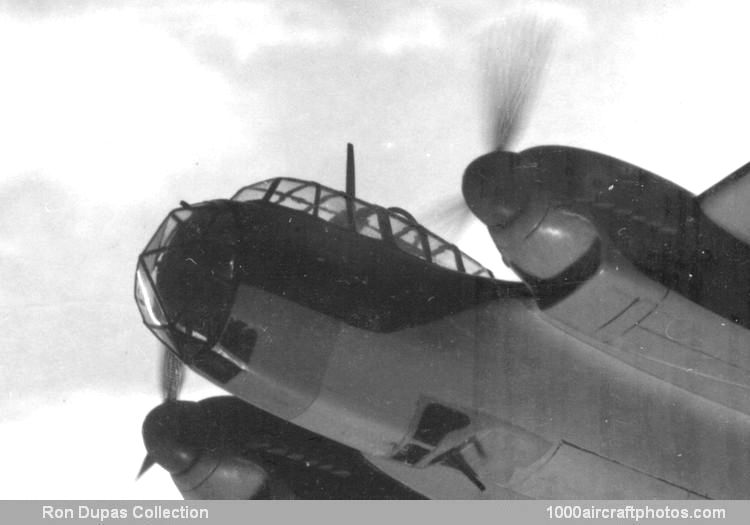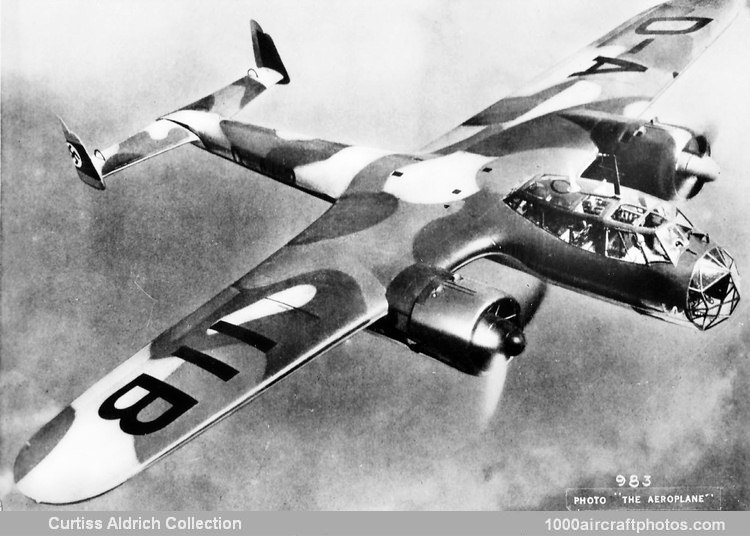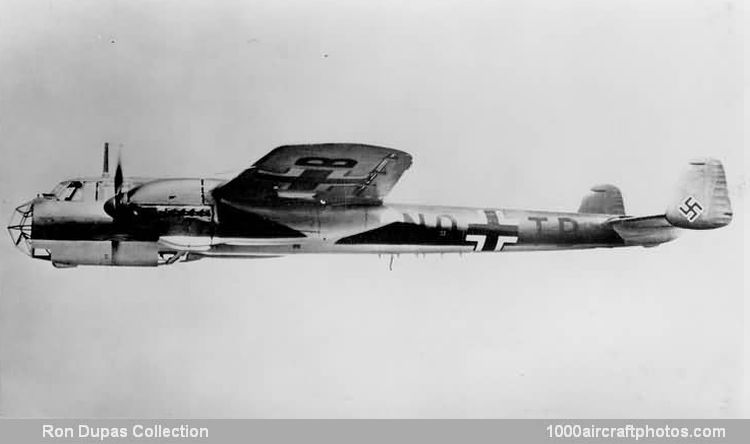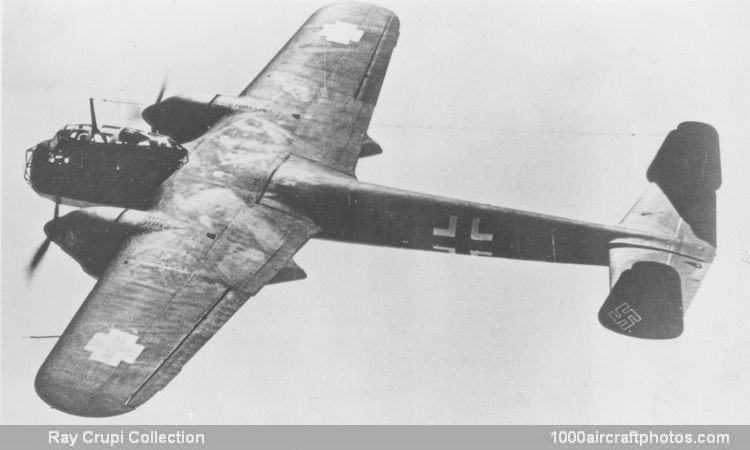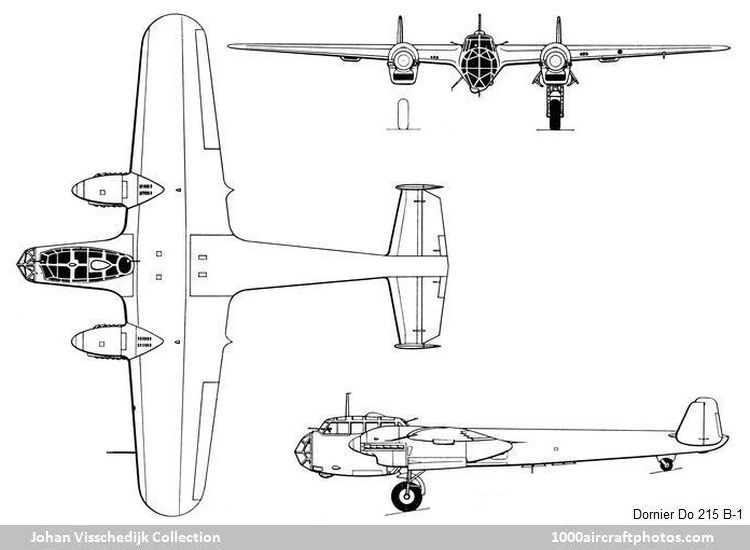04/30/2014. Remarks by
Johan Visschedijk: "This photo was distributed in the UK during WW II, most likely for aircraft recognition purposes. However, the following facts confirm the photo to be a fake. According to the code
"25+F03", it was used by Aufklärungskette of Stab III./KG 152 "Hindenburg" (formed April 1, 1936 in Barth; became Stab II./LG 1 November 1, 1938). The code
"25+F03" was used till the summer of 1939, whereafter a new code was introduced using number/letter + two letters (e.g.
"4N+AT"). On the other hand, the Do 215 B wasn't operational before 1940.
Furthermore, the aircraft is strangely illuminated from below, while the propellers seem to have been brushed in, and there seems to be no crew in the cockpit. Most likely this is a model.
The international interest aroused in the Do 17 in July 1937 by its success at Zürich was renewed in the following year by the début of the improved
Do 17 Z, and at an early stage in the development of the new model the Yugoslav government began to consider its capabilities as a potential production successor to the earlier
Do 17 K for which the Dravna Fabrika Aviona, or State Aircraft Factory, was in process of tooling.
Dornier therefore obtained permission to solicit export orders for the Do 17 Z, and although the model to be offered on the export market was, to all intents and purposes, identical to that being manufactured for the Luftwaffe, apart from equipment, the
RLM insisted on allocating a new type designation to the aircraft in export form.
Do 215 V1 (D-AIIB) (
Curtiss Aldrich Collection)
A pre-production Do 17 Z-0 was given the civil registration D-AIIB and, duly redesignated Do 215 V1, served as a four-seat medium reconnaissance-bomber demonstration aircraft. In view of the interest displayed by Yugoslavia, a second Do 17 Z-0 airframe was re-engined with a pair of Gnome & Rhône 14N 1/2 fourteen-cylinder air-cooled radials in place of the Bramo Fafnir 323A-1 nine-cylinder radials as the Do 215 V2 and demonstrated to the Yugoslav AF.
However, the Do 215 V2 did not offer a sufficient performance advance over the Do 17 K already in production in Yugoslavia, and therefore a third airframe was allocated to the Do 215 development program, and this, the Do 215 V3, was powered by two Daimler-Benz DB 601A twelve-cylinder liquid-cooled engines each rated at 1,075 hp for take off. Demonstrated during the late spring of 1939, the Do 215 V3 offered a note-worthy improvement in performance.
The Do 215 V3 was demonstrated to several foreign missions and, in the autumn of 1939, after the French government had cancelled a Swedish contract for the Breguet 694, the Swedish government placed an order with Dornier for eighteen Do 215 A-1 bombers, these being essentially similar to the Do 215 V3 and carrying a crew of four and a 2,205 lb (1,000 kg) bomb load.
Do 215 B-1 (
"ND+TB") (
Ron Dupas Collection) APS No. 248
Production of the Do 215 A-1 against the Swedish contract began late in 1939, but before the first delivery could be effected an embargo was placed on the export of the bomber which was adapted on the production line for long-range reconnaissance tasks with the Luftwaffe as the Do 215 B-0 and Do 215 B-1.
These aircraft reached the Luftwaffe in January-February 1940, and were promptly issued to 3.Aufkl.St./Ob.d.L., (Aufklärungsstaffel/Oberbefehlshaber der Luftwaffe, Reconnaissance Squadron/AF High Command) one of the Staffeln of the reconnaissance Gruppe (Group) attached to the Luftwaffe High Command). This unit was operating from Stavanger, Norway, shortly after the airfield's capture in April 1940, with thirteen Do 215 B-0 and B-1 aircraft and three Heinkel He 111s on strength.
Do 215 B-4 (D-AIIB) (
Ray Crupi Collection) APS No. 269
By this time, Dornier had been ordered to continue Do 215 production for the Luftwaffe, and in March 1940 began delivery of the Do 215 B-4 which differed from the B-1 in its camera equipment, an Rb 50/30 camera being mounted beneath the lower gun position and an Rb 20/30 camera being installed in the crew entry hatch. For combined bombing and reconnaissance missions five 110 lb (50 kg) bombs were normally carried, but up to ten 110 lb (50 kg) bombs could be carried on short-range missions, and for long-range and ferry missions the two 204.75 gal (775 l) standard fuel tanks in the wings between the fuselage and engine nacelles could be augmented by a 236.5 gal (895 l) auxiliary tank in the bomb-bay.
Defensive armament comprised two forward-firing 0.311 in (7.9 mm) MG 15 machine guns, two similar weapons firing to port and starboard from the rear of the cockpit, and a further pair of MG 15s firing aft from above and below the fuselage. The designation Do 215 B-2 had been allocated to a pure bomber variant that was not proceeded with, while Do 215 B-3 was the designation applied to the two examples supplied early in 1940 to the Soviet Union under the Russo-German Agreement.
By May 1940, all three Staffeln of the Aufkl.Gr./Ob.d.L. had Do 215 Bs on strength, 1.Staffel operating three Do 215 Bs, two Messerschmitt Bf 110 Ds and seven He 111s, and 2. and 3.Staffel both being completely Do 215 B-equipped with ten and eleven aircraft respectively. In the meantime, limited production of the Do 215 B was continued by Dornier until the beginning of 1941 when the 101st and last example left the assembly line. At that time, the only Luftwaffe unit operating the Do 215 B was still the Aufkl.Gr./Ob.d.L., and the 1.Staffel was operating a mixture of Do 215 B-4s and Do 217 A-0s on long-range reconnaissance sorties, and 2. and 3.Staffel were employing Do 215 B-4s in concert with other types, such as the Junkers Ju 88 A.
Earlier, nine Do 17 Z bomber airframes had been converted as night intruders under the designation Do 17 Z-10 Kauz II (Screech Owl II), and at the end of 1940 the Ju 88 C-2-equipped NJG 2 (Nachtjagdgruppe, Night Fighter Group) formed a fourth Staffel on this type at Gilze-Rijen in the Netherlands for nocturnal sorties against RAF bomber bases in East Anglia, Lincolnshire and Yorkshire.
Offering a generally superior performance to that of the Do 17 Z, early in 1941 it was decided to convert a dozen Do 215 B airframes for night intruder tasks. A special nose section had been designed for the Do 17 Z-10, this housing four 0.311 in (7.9 mm) MG 17 machine guns and two 0.787 in (20 mm) MG FF cannon, and this was applied to the Do 215 B which thus became the Do 215 B-5. These aircraft were delivered to 4./NJG 2 in the spring and early summer of 1941, continuing nocturnal sorties over Britain until the unit was transferred to Sicily in the following October.
Early in 1942, a number of the Luftwaffe's Do 215 B-4s were transferred to the Hungarian AF, replacing the He 111 H and with the I Long-Range Reconnaissance Group subsequently operating on the Russian Front until supplanted by the Ju 88. In Luftwaffe service, the Do 215 B had virtually disappeared from first-line service by 1942, and surviving examples were mostly relegated to various test roles."
